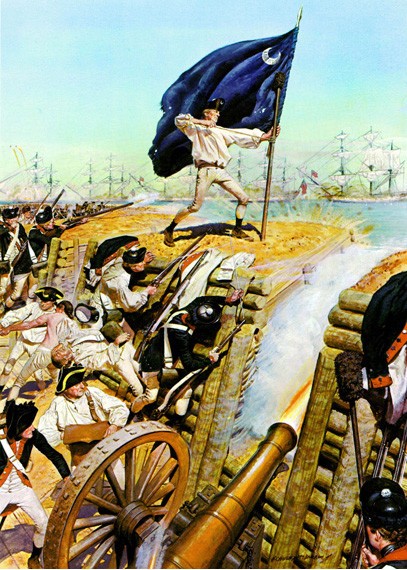The Battle of Sullivan’s Island
On this date 243 years ago, just days before the United States declared independence, the Royal Navy were poised capture the port of Charleston (modern-day South Carolina). Standing in their way, however, was an an unfinished American garrison on Sullivan’s Island. Over the next 12 or so hours, American militiamen held off a British flotilla, which included two fourth-rate ships of the line, six frigates, and a bomb vessel. From the U.S. Army Center of Military History:

“In June 1776 British Admiral Peter Parker ‘s fleet, loaded with troops commanded by General Henry Clinton, made an appearance off Charleston, South Carolina. The city, feverishly preparing for an attack, had partially completed Fort Sullivan, Charleston’s key defense position. The 30-gun fort on Sullivan’s Island was hastily constructed from the most abundant materials available, palmetto logs and sand. The garrison, commanded by Colonel William Moultrie, contained over 400 men including 22 artillerists and the 2d South Carolina Provincial Regiment.
“Because of a sand bar the British delayed their attack on Charleston until 28 June 1775 while they lightened ship. Clinton’s 2,000 British soldiers, landing on adjacent Long Island, were unable to cross an estuary to join in the attack. The fleet began its bombardment at a range of about 400 yards. Low on powder, Moultrie directed his men to fire slowly and accurately in reply.
“During the engagement a shell struck the flagpole, and the blue South Carolina banner fell outside the fort. Sergeant William Jasper retrieved it and, oblivious to British fire, secured the flag to a makeshift staff.
“The falling shells, absorbed by the soft palmetto loge and sand, caused little damage to the fort and few casualties. Even shells that did enter the fort buried themselves in the swampy parade ground. The wooden frigates on the other hand were riddled with shot. One explosion blew away Sir Peter Parker’s breeches.
“Finally, after more than ten hours of firing, the British fleet withdrew and several weeks later sailed for New York. For three years following the defeat at Charleston the British were to leave the South unmolested and the Southern Tories, who were undoubtedly numerous, without succor.”
By 9 p.m., Adm. Parker called off the bombardment. American gunfire severely damaged both of his fourth-rate warships and inflicted some 220 casualties. An uncharted sandbar had grounded three frigates during the engagement, and the British were unable to free one and set it on fire to prevent it from being captured. Enemy ships would not return to Charleston for nearly four years, leaving a vital southern port in American hands and possibly altering the course of the war.
In honor of the victory at Sullivan’s Island, Palmetto tree was added to the crescent on the Moultrie Flag (designed by Col. Moultrie in 1775 for S.C. soldiers during the upcoming war), which became the state flag, and South Carolina’s nickname would become “The Palmetto State.” Renamed Fort Moultrie after the battle, the coastal defense fortification guarded Charleston Harbor until 1947.
Editor’s note: A modified version of this post was originally published here on May 3, 2010.
This incident is the reason SC’s flag now has a palmetto tree in the center. Thanks. I am a SC Guardsman.
What is your POINT?
America is still standing & being oxenized by God Almighty.
The South is part of God’s Beginning & no man will ever take it from HIM. Have a bless uncolored Day.